Russian Arctic activity slowly heating up

By John Howes, London
Earlier this year, Russian President Vladimir Putin had talks with US President Bill Clinton on encouraging production sharing agreements as a way of advancing foreign investment in Russia. This was recognized as the fulfillment of the "Energy Strategy of Russia to 2025" program, designed to deliver an oil production volume of 305-320 million tons and natural gas production volume of 650-680 billion cu meters by 2005. The program was originally launched to drag the Russian oil industry out of the depression it plunged into in 1998 following loss of investor confidence and weak oil price. Standing as the world's third largest oil producer, the industry is extremely important to the Russian economy, representing more than more than 45% of Russia's export earnings.
 The majority of current oil reserves lie in Western Siberia, particularly in the Tuymen area. According to a report published in 1997, there are in excess of 450 named fields in the West Siberian Basin. Of the 123 developed fields, nine are in the supergiant category with reserves of 5 billion bbl of oil, 73 have reserves of more than 350 million bbl.
The majority of current oil reserves lie in Western Siberia, particularly in the Tuymen area. According to a report published in 1997, there are in excess of 450 named fields in the West Siberian Basin. Of the 123 developed fields, nine are in the supergiant category with reserves of 5 billion bbl of oil, 73 have reserves of more than 350 million bbl.
If the industry is to meet its intention to carry an even bigger export burden, new reserves have to be found and developed. It has long been recognized that the most promising location includes the Russian Arctic and the Sakhalin area. Sakhalin lies considerably below the Arctic Circle, although parallels can be drawn between the harsh environments and production strategy.
In October 2000, Russian scientists commenting upon an expedition by the research ship Academic Fyodorov presented evidence at a geological conference that the country's arctic undersea continental shelf is 1.2 million sq km larger than previously thought, entitling Russia to argue to the UN that it can claim oil and gas resources beyond its 320 km offshore economic zone.
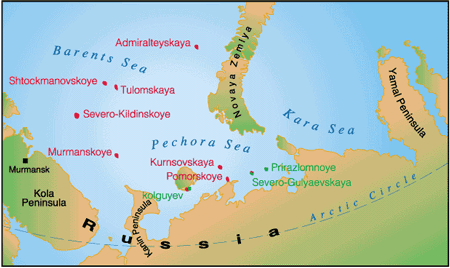
The Russian offshore arctic sector is located in the Barents and Pechora Seas. The climate is affected by the warm Atlantic and the cold arctic systems, resulting in varied weather and regular storms. The average temperature in February in the North is –25°C and –4°C in the Southwest. The average temperature in August in the North is 1°C and 10°C in the Southwest. In April, approximately 75% of the sea is covered with floating ice. The minimum ice cover is in late August when the ice frontier is above 78° North latitude.
Northern Territories
According to Vagit Alekperov, president of the Russian oil company Lukoil , the key to opening up the area is the development of the Northern Territories in the Timan-Pechora oil and gas province, which enclose about 1.2 million acres. The area begins about 1,000 miles north of Moscow and stretches to the Barents Sea.
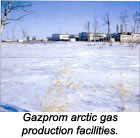 Principal in the Northern Territories are the Yuzhno-Khylchuyu (Y-K), Khylchuyu, Yareiyu, and Inzyrei Fields. It is estimated that these could hold recoverable reserves of over a billion bbl of oil and 2 trillion cu ft of natural gas. Their development would have an estimated US$25 billion impact on the Russian economy over the life of the project.
Principal in the Northern Territories are the Yuzhno-Khylchuyu (Y-K), Khylchuyu, Yareiyu, and Inzyrei Fields. It is estimated that these could hold recoverable reserves of over a billion bbl of oil and 2 trillion cu ft of natural gas. Their development would have an estimated US$25 billion impact on the Russian economy over the life of the project.
The Y-K Field will be developed jointly by Lukoil, AGD, and Conoco. With a 40% share, Conoco has already invested $100 million to prepare the field for development and for preliminary evaluation of the other fields and exploration acreage in the block. Preliminary engineering work on the field indicates it may require about $2 billion in capital costs to be developed.
The other huge prospect is the Shtokmanovskoye natural gas project that Conoco is also working on with Gazprom/Rosshelf, TotalFinaElf, Norsk Hydro, and Fortum. In June 2000, Vladimir Putin signed the law that would enable negotiations for a production sharing agreement (PSA).
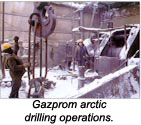 The Shtokmanovskoye Field is located in the central part of the Barents Sea, about 600 miles northeast of Murmansk, in about 1000 ft of water. It was discovered in 1988. The Russian Federation estimates reserves for the field of about 100 trillion cu ft of gas and 250 million bbl of condensate based upon data from six wells penetrating the four separate reservoirs. At peak production, the field could produce as much as 20% of the current daily gas production of Russia.
The Shtokmanovskoye Field is located in the central part of the Barents Sea, about 600 miles northeast of Murmansk, in about 1000 ft of water. It was discovered in 1988. The Russian Federation estimates reserves for the field of about 100 trillion cu ft of gas and 250 million bbl of condensate based upon data from six wells penetrating the four separate reservoirs. At peak production, the field could produce as much as 20% of the current daily gas production of Russia.
Development envisages the construction of two ice-resistant drilling platforms, four submarine units with 12 well clusters, submarine in-field pipelines and cable wires, 30,000-ton submarine storage tanks for each drilling platform for condensate, with a terminal for loading tankers and a 635-km main pipeline to the Kola Peninsula coast.
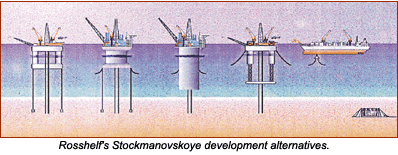
Of the western companies in Russia, Conoco has been the most prominent. Its history dates back to 1991, when it formed Polar Lights, the 50/50 joint venture with Arkhangelskgeologia to develop the Ardalin Field in Northern Russia's Timan Pechora Basin. Ardalin is the largest of several oil fields in the Polar Lights joint-venture area and is located in the arctic tundra, approximately 1,000 miles (1,600 km) northeast of Moscow.
To transport the oil from the Ardalin complex, a 40-mile (65-km) above-ground, insulated pipeline was constructed. The field contains more than 110 million bbl (16 million tons) of recoverable reserves. Its peak production of about 25,000 b/d (3,700 ton/day) was reached in 1996.
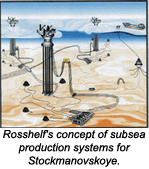 However, it would be wrong to conclude that Conoco was the only western company active in Russia. Last year, TotalFina (50% operator) and its partners, Norsk Hydro (40%) and the Nenets Oil Company (10%), announced the start-up of oil production on horizons two and three of the Khariaga Field, located north of the Arctic Circle, in the Timan-Pechora Basin in the Nenets Autonomous Territory. The oil is transported to Usinsk (150 km) using the KomiTEK collection system and then transported via the Transneft system over the 2,400 km to the western border of the Russian Federation, from where it is exported to Europe.
However, it would be wrong to conclude that Conoco was the only western company active in Russia. Last year, TotalFina (50% operator) and its partners, Norsk Hydro (40%) and the Nenets Oil Company (10%), announced the start-up of oil production on horizons two and three of the Khariaga Field, located north of the Arctic Circle, in the Timan-Pechora Basin in the Nenets Autonomous Territory. The oil is transported to Usinsk (150 km) using the KomiTEK collection system and then transported via the Transneft system over the 2,400 km to the western border of the Russian Federation, from where it is exported to Europe.
Khariaga is the first onshore field to come on stream in Russia within the framework of a production sharing agreement. Production during the initial development phase is expected to reach 10,000 b/d.
Click here for a recent report on drilling in the Pechora Sea.
